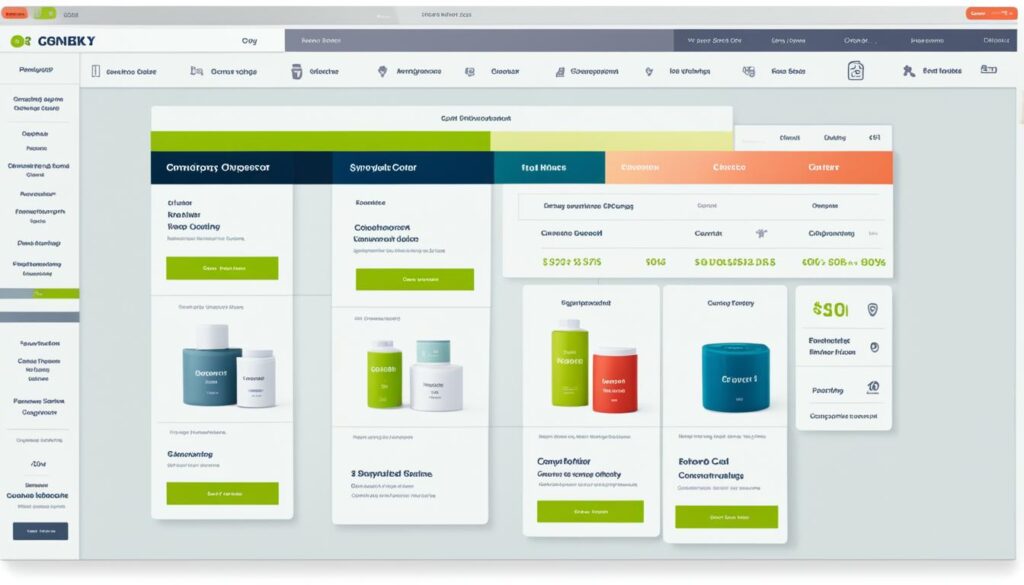Did you know that digital products can have gross profit margins of 75-80% or more? Today, selling virtual products online is a big opportunity. You can sell e-books, online courses, software, and more. Learning how to make digital products can boost your business, keep customers coming back, and help you stand out.
Successful digital products solve problems fast and well for their users. Know who you’re making the product for, build a solid base, use technology, and market smartly. This way, you can make the most of your digital products. If you’re an entrepreneur, product manager, or marketer, mastering digital products is key to doing well online.
When selling online, planning and knowing your audience are key. You need to research the market, come up with ideas, develop, design, test, launch, and market your product. Each step is important for success. Focus on making products easy to use, listen to what users say, and use different marketing ways. This approach helps create products that customers love and buy more.
Key Takeaways
- Digital products offer high profit margins and the potential for recurring revenue
- Understanding your target audience is crucial for creating successful digital products
- Effective marketing strategies, such as content marketing and paid advertising, can help drive sales
- Focusing on user experience and gathering feedback can improve digital product success
- Strategic planning and a strong product foundation are essential for unlocking online success
Understanding the Digital Product Landscape

The digital product world is always changing, full of chances for entrepreneurs and businesses. It lets them make and sell digital downloads and earn passive income. With new tech, the need for cool and easy-to-use digital products is growing. This makes it a great time to jump into this booming market.
Types of Digital Products
Digital products come in many formats, each for different niches and people. Some top types include:
- Website templates
- Online courses
- Memberships
- Canva templates
- Font licenses
- Stock photos
- Copy templates
- Calculators
- Spreadsheets
- Branding templates
- Party game printables
- Lightroom presets
- Notion templates
- Legal templates
There’s a wide variety of digital products out there. They’re perfect for creatives, business owners, or anyone wanting to learn new things or make work easier.
Benefits of Selling Digital Products
Selling digital products has many perks for entrepreneurs and content creators. Some main benefits are:
- Low overhead costs: You don’t have to worry about inventory, storage, or shipping. This makes them very profitable and easy to handle.
- Global reach: The internet lets you reach customers worldwide. This grows your customer base and boosts your earnings.
- Passive income: Once you make a digital product, you can sell it over and over without extra work. This creates a steady income for your business.
- Flexibility: You can work from anywhere, anytime. This gives you the freedom to create and sell on your terms.
By investing in digital product development, companies can improve operations, cut costs, and focus on new ideas. This leads to more innovation and better experiences for users.
As the digital world keeps changing, it’s key to stay up-to-date with new trends, tech, and best practices in making digital products. Knowing about the different types of products and their benefits helps you make and sell products that your audience will love. This way, you can earn steady passive income for your business.
Identifying Your Niche and Target Audience

To make a digital product successful, you need to know your niche and your audience. Focus on a specific group to make your product fit their needs and likes. This way, you can stand out and build a loyal customer base.
Researching Your Market
Doing deep market research is key to finding a profitable niche and knowing your audience. Look at trends to see what digital products are popular, like ebooks and video tutorials. See what others are doing to make your product unique. Use tools like surveys and social media to learn what your audience likes and needs.
Creating Buyer Personas
Creating buyer personas helps you understand your ideal customer better. Think about things like age, gender, and interests when defining your audience. Use data to make your product and marketing better. Talk to your audience on social media to build loyalty and brand awareness.
| Buyer Persona Characteristic | Examples |
|---|---|
| Age | 25-45 years old |
| Gender | Male and Female |
| Location | Urban areas in the United States |
| Interests | Technology, Personal Development, Entrepreneurship |
| Pain Points | Lack of time, Limited resources, Need for guidance |
Analyzing Competitors
Looking at your competitors helps you find market gaps and ways to stand out. Study their products, prices, and marketing to learn what works. Use this info to make your product unique and appealing to your audience.
By deeply understanding your target audience and crafting a digital product that addresses their specific needs, you lay the foundation for a successful and profitable online venture.
Developing Your Digital Product

Now that you know your niche, audience, and competitors, it’s time to start making your product. You need to pick the best format, make top-notch content, and design a great user experience. These steps will help you make a product that connects with your audience and stands out.
Choosing the Right Format
Picking the right format is key. It should match what your audience likes and solve their problems. Here are some options:
- Ebooks and guides
- Online courses and tutorials
- Software and mobile applications
- Templates and printables
- Membership sites and exclusive content
Think about what fits your skills, what your audience needs, and what’s in demand. The right format can make a big difference in your product’s success.
Creating High-Quality Content
After picking a format, focus on making great content. Your product should give real value to users and solve their issues. Keep these tips in mind:
- Do thorough research to make sure your content is right and up-to-date.
- Break down hard topics into easy parts.
- Write in a way that keeps your audience interested.
- Add visuals like images, infographics, and videos to help users understand better.
- Give practical tips and examples that users can use in real life.
Putting effort into making quality content makes you an expert in your field. It also builds trust with your audience.
Designing an Engaging User Experience
A smooth and easy user experience is crucial for your product’s success. Work on making your product look good and fun to use. Think about these UX design aspects:
| UX Aspect | Description |
|---|---|
| Navigation | Make sure your product is easy to use, with clear menus and a logical layout. |
| Visual Design | Use nice colors, fonts, and layouts to make your product look good. |
| Interactivity | Add fun stuff like quizzes, assessments, and exercises to keep users interested. |
| Responsiveness | Make sure your product works well on different devices and sizes. |
| Loading Speed | Keep loading times short to keep users happy and avoid frustration. |
A well-designed user experience really helps with user satisfaction, keeping users around, and making your product a success. Keep improving your product based on what users say and tests show to meet their needs.
By focusing on the right format, quality content, and a great user experience, you’re on your way to a successful digital product. This product will connect with your audience and help you reach your goals.
Pricing Strategies for Maximum Profitability

Selling digital products requires smart pricing to make the most profit. The digital products market is set to hit over $200 billion in revenue soon. Knowing how to price your products can greatly affect your earnings.
Consider the type of digital product you’re selling. Prices vary based on value, costs, and demand. For instance, mini online courses usually cost between $47 and $147, averaging $137. Courses with more content and multimedia can go for $1,000 to $3,000.
Ebooks are often cheaper, priced from $7 to $27. Software templates like Canva or Notion templates range from $5 to $50. Mobile apps often use free or subscription models, with monthly fees from $0.99 to $9.99.
Think about these pricing strategies:
- Value-based pricing: Price based on how much your product adds value to the customer. 81% of customers pay more for products that meet their needs.
- Cost-based pricing: Make sure your prices cover all costs, including fees, marketing, and hosting.
- Competitor-based pricing: Look at what your competitors charge to stay competitive. But don’t price yourself too low.
Other strategies to consider include:
| Pricing Strategy | Description |
|---|---|
| Dynamic pricing | Change prices based on market and customer demand |
| High-low pricing | Start high, then lower prices when demand drops |
| Penetration pricing | Start with very low prices to shake up the market |
| Tiered pricing | Offer different prices for different customer groups |
Raising prices by 20% can often be a viable strategy to cover expenses and increase profitability.
The secret to great digital product pricing is knowing your audience, the value you offer, and your business goals. With careful thought and a solid pricing strategy, you can boost your profits and succeed in the digital market.
Building Your Online Presence
In today’s digital world, having a strong online presence is key to your digital product’s success. A professional website, a unique brand identity, and social media can help you reach your audience and boost sales.
Creating a Professional Website
Your website is the heart of your digital product. It should highlight your offerings, share valuable info, and make user experience smooth. Here are some key stats:
- Around 93% of online activities start at a search engine.
- 95% of consumers look for clear images, product details, and stock info before buying online.
- 55% of shoppers prefer to shop online.
To make a professional website that grabs attention and boosts sales, focus on:
- Easy navigation and a user-friendly design
- High-quality visuals and engaging product descriptions
- Being mobile-friendly for easy browsing on any device
Establishing Your Brand
A strong brand identity makes you stand out and connect with your audience. Here’s what to keep in mind:
74% of consumers follow brands on social media, and 96% interact with the brands they follow.
To create a lasting brand:
- Develop a distinct brand voice and look
- Keep your brand message consistent across all platforms
- Connect with your audience and build relationships
Leveraging Social Media
Social media is a powerful tool for reaching and engaging your audience. Check out these stats:
| Platform | Users (in millions) | Percentage of U.S. Population |
|---|---|---|
| 255 | 77% | |
| 140 | 42% | |
| 68 | 21% |
To make the most of social media:
- Find out where your target audience hangs out online
- Share valuable, engaging content often
- Talk to your followers and grow a community around your brand
By focusing on a professional website, a strong brand, and social media, you can create a strong online presence. This will help drive the success of your digital product.
Marketing Your Digital Product
Marketing your digital product is key to its success. A strong digital product marketing strategy can help you get leads, make your brand known, and boost sales. Let’s look at some important marketing channels and tactics to help your product stand out online.
Content Marketing
Content marketing is a great way to grab and keep your audience’s attention. By sharing valuable, informative content about your digital product, you become a go-to source in your field. This builds trust with potential customers. Here are some content marketing ideas:
- Blog posts and articles
- Videos and tutorials
- Infographics and visual content
- Podcasts and interviews
- Case studies and success stories
Content marketing funnels work by sharing valuable content to lead people to free offers, like ebooks or webinars, in exchange for their email addresses. This helps you build a list of people interested in your product.
Email Marketing
Email marketing is a strong tool for growing leads and promoting your product. By building an email list of people interested in your niche, you can talk directly to potential customers. Here are some email marketing tips:
- Welcome sequences for new subscribers
- Regular newsletters with useful content
- Promotional campaigns for new products or special deals
- Abandoned cart emails for incomplete purchases
- Segmentation and personalization for better targeting
Email marketing often has the highest return on investment among digital marketing methods. For example, OptinMonster helped a business get 3,000 new subscribers every month, showing how effective email marketing can be for growth.
Paid Advertising
Paid ads help you reach more people and bring targeted traffic to your product. Some top paid ad channels are:
- Social media ads (Facebook, Instagram, Twitter, LinkedIn)
- Search engine marketing (Google Ads, Bing Ads)
- Display advertising (banner ads, retargeting)
- Sponsored content and influencer partnerships
When running paid ads, make sure to target the right audience, use catchy ad copy and visuals, and make your landing pages convert well.
Affiliate Marketing
Affiliate marketing is a popular way to promote digital products. By working with affiliates, you can use their audience to sell more of your product. Affiliates make money from each sale they help make, making it good for both of you. To do well in affiliate marketing:
- Create a good affiliate program with competitive commissions
- Find affiliates in your niche
- Give affiliates marketing materials and support
- Keep an eye on how well affiliates are doing
| Digital Product | Marketing Strategy | Potential Impact |
|---|---|---|
| Online Course | Content Marketing | Build authority and generate leads |
| Ebook | Email Marketing | Nurture leads and drive sales |
| Digital Template | Paid Advertising | Reach a wider audience and drive targeted traffic |
| Software Tool | Affiliate Marketing | Leverage influencers and generate commissions |
Using a mix of digital product marketing strategies can help you reach your audience, make your brand known, and increase sales. Try different tactics, see what works, and keep improving your marketing to succeed in the fast-paced digital product world.
Optimizing for Conversions and Sales
To hit your digital product’s revenue goals, focus on making more people buy your stuff. Even a small boost in your buy rate can greatly increase sales. For example, aiming for $10,000 a month from a $400 website template means you need to sell 25 of them. With a 1.5% conversion rate, you’d need 1,667 people to see your product.
Most companies aim for a 2-5% conversion rate, with top performers hitting 10% or more. E-commerce stores on Shopify average a 2.5% conversion rate, but can jump to 4-6% with better website and checkout pages. By using smart strategies, you can double your leads and customers.
Creating Compelling Sales Pages
Your sales page is key to getting people to buy your digital product. Make it stand out by focusing on what your product does best, answering doubts, and showing social proof. Use simple language and eye-catching visuals to keep visitors hooked and ready to buy.
“A well-designed sales page can be the difference between a visitor simply browsing and a customer making a purchase.”
Here’s what to include on your sales page:
- A strong headline that clearly states the main benefit
- Detailed descriptions and features of your product
- Testimonials and case studies from happy customers
- A clear, big call-to-action button
- A money-back guarantee or free trial to ease customer worries
Implementing Effective Calls-to-Action
CTAs are key to getting people to buy. They should be clear, big, and in the right spots in your sales funnel. Use words that tell people what to do next and create a sense of urgency.
Here are tips for great CTAs:
- Use different colors to make your CTA buttons pop
- Put CTAs where people will see them first and throughout your page
- Try out different CTA words and places to see what works best
- Make sure your CTAs work well on phones and are easy to tap
| Element | Description | Example |
|---|---|---|
| Headline | A strong, benefit-driven headline | “Boost Your Website’s Performance with Our Optimized Template” |
| CTA Button | A clear, prominent call-to-action button | “Download Now” |
| Social Proof | Testimonials or case studies from satisfied customers | “This template helped me increase my website’s conversion rate by 30%!” |
By focusing on making more sales, creating great sales pages, and using strong CTAs, you can boost your digital product’s sales. This will help you meet your revenue goals.
Scaling Your Digital Product Business
Scaling your digital product business is key to long-term success. By using business scaling strategies, you can grow your customer base and boost your income. Building an engaged email list is crucial for this growth. It helps you keep getting traffic and sales for your products.
Top digital product businesses know how to attract their own audience. They use marketing strategies like social media, paid ads, podcasts, and blogs. These methods help you reach more people and build strong relationships with them.
“Scaling a digital product allows businesses to improve their market share and find new customers. A scalable business model is more beneficial in the long run.” – Artkai
A study by BCG found that scaling digital solutions can increase revenue by 9% to 25%. It can also save costs by 8% to 28%. Scaling multiple solutions can lead to a 17% revenue increase and a 17% cost reduction company-wide. Successful scaling can result in 3x higher returns, up to 20% revenue growth, and 15-20% cost savings.
| Scaling Strategy | Revenue Increase | Cost Savings |
|---|---|---|
| Individual digital solutions | 9% to 25% | 8% to 28% |
| Multiple solutions (enterprise-wide) | Nearly 17% | 17% |
Having skilled IT specialists on your team is vital for scaling your digital product smoothly. They ensure consistency and prevent bottlenecks. Continuous integration and delivery, test automation, and widespread CI/CD improve quality and make collaboration easier.
Scaling your digital product business opens up new market opportunities and attracts more customers. Embrace business scaling, audience building, and marketing strategies to grow your business and achieve long-term success.
Conclusion
In today’s fast-changing digital world, learning how to make digital products is key for growing your online business. Knowing your audience, using the latest tech, and making products that solve real problems is essential. This approach can help you grow and make more money over time.
The global digital transformation market is set to hit USD 4.46 billion by 2029, growing at a 21.32% annual rate. This shows the huge potential for businesses that can navigate the digital product world well.
But making a digital product isn’t enough. To really make your online business shine, focus on building a loyal audience and using smart marketing to get more traffic and sales. Use content marketing, email marketing, paid ads, and affiliate marketing to reach your customers and show them what makes your product special.
By always delivering top-notch content and connecting with your audience on different platforms, you can become a trusted expert in your field. This builds strong relationships with your customers that last.
The secret to digital product success is being able to adapt, innovate, and keep improving your products based on what users say and market trends. By staying flexible and in tune with your customers’ needs, you can keep growing your online business for the long haul. With the right mindset, strategies, and dedication to excellence, you can become a successful digital product creator. This opens the door to making those $10k months and more.
FAQ
What are digital products?
Digital products are things like e-books, online courses, and software. They also include digital downloads, website templates, and more. Think of things like memberships, Canva templates, and font licenses too.
Stock photos, copy templates, calculators, and spreadsheets are part of it. So are branding templates, party game printables, Lightroom presets, and Notion templates. And let’s not forget legal templates.
What are the benefits of selling digital products online?
Selling digital products online has many perks. For one, you don’t have to worry about inventory or shipping. It’s also a great way to make money without much effort.
Plus, you can reach customers all over the world. This means you can make more money and grow your business.
How do I identify my target audience for my digital product?
To find your target audience, start by learning about their likes and needs. Do some market research to see what they’re looking for. Make buyer personas to get a clear picture of who you’re selling to.
What should I consider when developing my digital product?
Think about what format works best for your audience and the problem you’re solving. Make sure your content is top-notch and meets their needs.
Make sure your product is easy to use and looks good. It should work well and be fast.
How do I price my digital product for maximum profitability?
Picking the right price is key to making money with digital products. Courses usually cost between and ,000. Most are in the 0 to ,000 range.
Website templates are priced between 0 and
FAQ
What are digital products?
Digital products are things like e-books, online courses, and software. They also include digital downloads, website templates, and more. Think of things like memberships, Canva templates, and font licenses too.
Stock photos, copy templates, calculators, and spreadsheets are part of it. So are branding templates, party game printables, Lightroom presets, and Notion templates. And let’s not forget legal templates.
What are the benefits of selling digital products online?
Selling digital products online has many perks. For one, you don’t have to worry about inventory or shipping. It’s also a great way to make money without much effort.
Plus, you can reach customers all over the world. This means you can make more money and grow your business.
How do I identify my target audience for my digital product?
To find your target audience, start by learning about their likes and needs. Do some market research to see what they’re looking for. Make buyer personas to get a clear picture of who you’re selling to.
What should I consider when developing my digital product?
Think about what format works best for your audience and the problem you’re solving. Make sure your content is top-notch and meets their needs.
Make sure your product is easy to use and looks good. It should work well and be fast.
How do I price my digital product for maximum profitability?
Picking the right price is key to making money with digital products. Courses usually cost between $50 and $4,000. Most are in the $750 to $2,000 range.
Website templates are priced between $100 and $1,500, averaging about $400. Memberships can be monthly, costing $5 to $500. Other products have different prices based on what they offer and the demand.
How can I build my online presence to market my digital product effectively?
Build a professional website to show off your product and your brand. Make sure it’s easy to use. Create a brand that speaks to your audience.
Use social media to connect with people and promote your product. Share valuable content to draw in your target audience.
What marketing strategies should I use to promote my digital product?
Use content marketing, email marketing, paid ads, and affiliate marketing to promote your product. Share useful content to grab your audience’s attention. Email marketing lets you directly connect with your customers.
Paid ads can help you reach more people. Affiliate marketing uses influencers to promote your product and earn money from sales.
How can I optimize my digital product for conversions and sales?
Make your sales pages compelling by highlighting your product’s benefits. Address any doubts and show social proof to build trust. Use clear calls-to-action to encourage buying.
What strategies can I use to scale my digital product business?
Grow your business by building an email list for more traffic and sales. Be your own influencer to drive sales. Use social media, paid ads, podcasting, and blogging to market your products.
Long-form content is a budget-friendly way to build SEO, create scheduled content, and connect with your audience. It’s a great way to offer value for free.
,500, averaging about 0. Memberships can be monthly, costing to 0. Other products have different prices based on what they offer and the demand.
How can I build my online presence to market my digital product effectively?
Build a professional website to show off your product and your brand. Make sure it’s easy to use. Create a brand that speaks to your audience.
Use social media to connect with people and promote your product. Share valuable content to draw in your target audience.
What marketing strategies should I use to promote my digital product?
Use content marketing, email marketing, paid ads, and affiliate marketing to promote your product. Share useful content to grab your audience’s attention. Email marketing lets you directly connect with your customers.
Paid ads can help you reach more people. Affiliate marketing uses influencers to promote your product and earn money from sales.
How can I optimize my digital product for conversions and sales?
Make your sales pages compelling by highlighting your product’s benefits. Address any doubts and show social proof to build trust. Use clear calls-to-action to encourage buying.
What strategies can I use to scale my digital product business?
Grow your business by building an email list for more traffic and sales. Be your own influencer to drive sales. Use social media, paid ads, podcasting, and blogging to market your products.
Long-form content is a budget-friendly way to build SEO, create scheduled content, and connect with your audience. It’s a great way to offer value for free.





